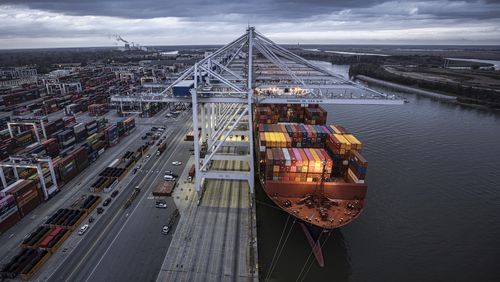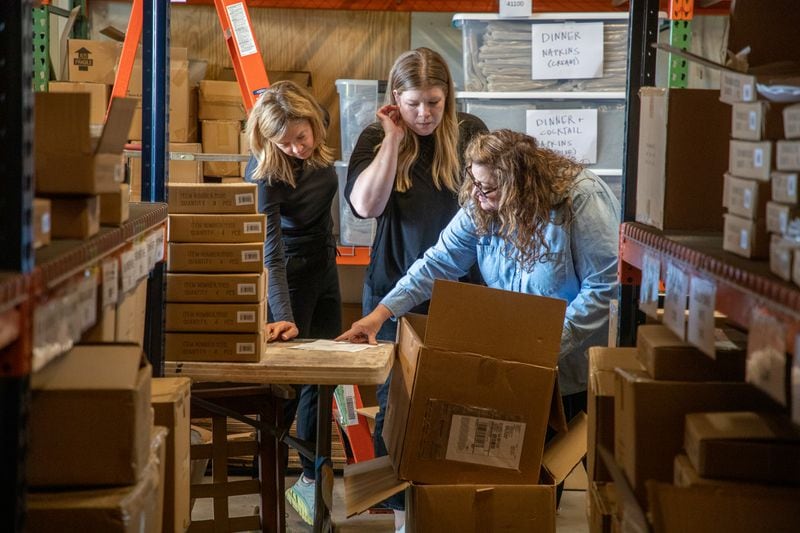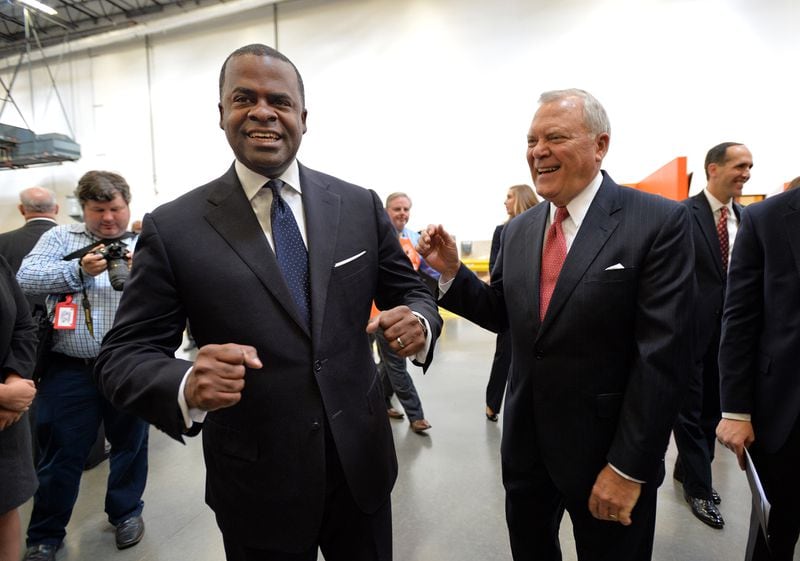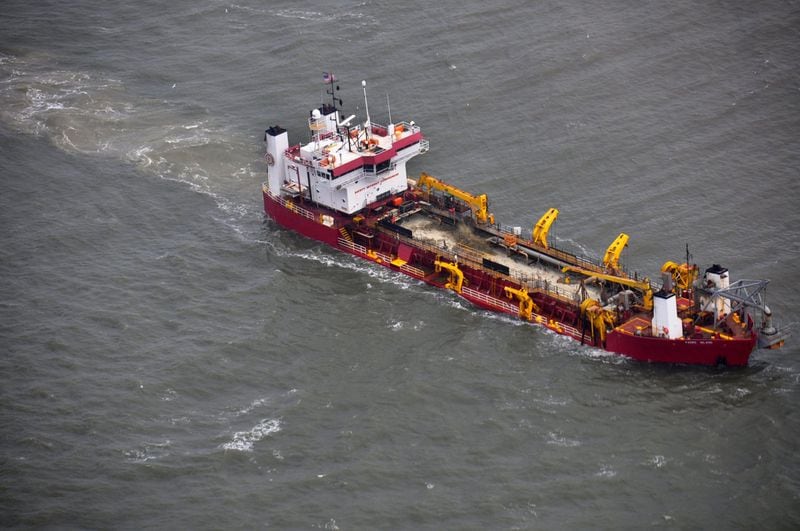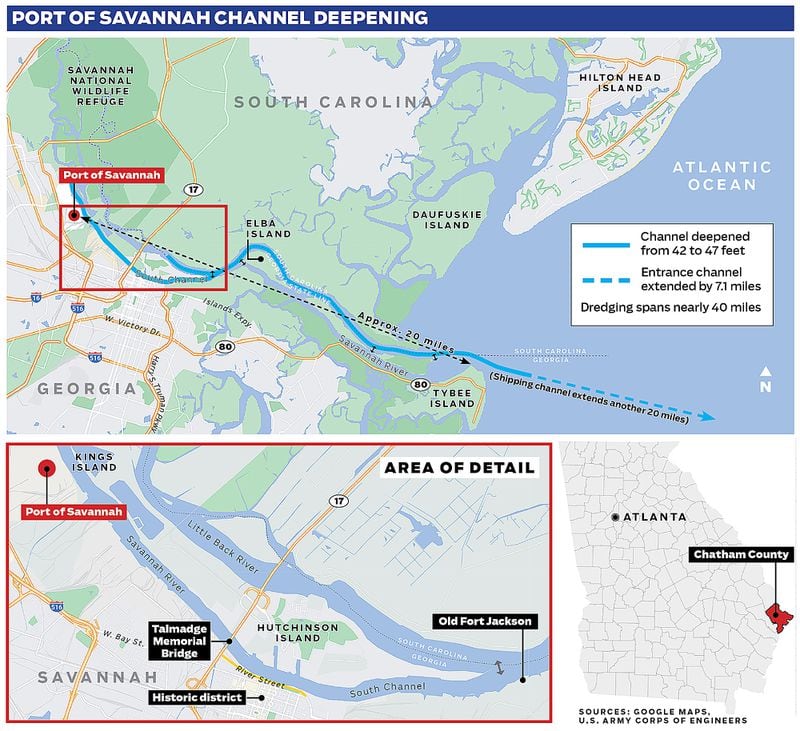SAVANNAH — After decades of political wrangling and environmental roadblocks and nearly seven years of dredging muck from the river bottom, one of Georgia’s most anticipated economic development projects — the nearly $1 billion deepening of the Savannah River channel — is finally complete.
The work to deepen 38 miles of winding, narrow river channel by five feet was designed to make importing and exporting goods cheaper and more efficient aboard ever-larger freighters. The deepening will also help Savannah, now the third-busiest port in the U.S., stay ahead of expansions at competing harbors on the Eastern Seaboard, ports officials say.
Economists say the economic impact from the Savannah port washes over the entire state. Logistics jobs tied to the Savannah port have nearly doubled statewide in the past two decades. But a lot of work lies ahead for Georgia to keep its competitive edge.
Billions in new infrastructure projects — some underway and others in the pipeline — are in the works. The Georgia Ports Authority, the government entity that operates the Savannah port, wants to grow its capacity by more than a quarter from 7.5 million shipping containers a year today to 9.5 million annually in next three years.
“This is for our continued economic well-being,” said Joel Wooten, chairman of the authority board. “Georgia continues to have incredible economic development and the ports have to have the capacity for us to be part of that.”
Companies like Relish, a small, but ambitious seller of high-end dishware, rely on the Savannah port to get its products to customers on time.
A few years ago, Relish shifted from a Chinese supplier to a family-owned factory in Guatemala for better reliability and quicker turnaround. But they still ran into problems.
Credit: Steve Schaefer
Credit: Steve Schaefer
Not because of distance, but because shipping containers hit snafus after they were unloaded, said Susan Peterson, co-owner of the Rome-based company.
“We were using the ports in Miami and Houston,” she said, “and sometimes a container would be sitting there for three days.”
For a small business, delays can be fatal. And the snarls grew dramatically worse last year, she said.
“It wasn’t unusual to have a container sitting here for a month,” she said. “It was maddening.”
Routing everything through Savannah has virtually eliminated those issues, she said.
“We are doing our best now to source everything through Savannah,“ Peterson said.
The Savannah port is a conduit for companies that export abroad, especially Georgia kaolin, timber and poultry products on their way to Asia. Yet the lion’s share of shipments are coming to American companies that import components they put into U.S.-made products, as well as finished goods like electronics, toys, clothes and furniture, that are assembled overseas and sold directly to American consumers.
In 2019, nearly a half-million jobs existed because of the ports, up about 80% from 276,000 in 2003, said Jeff Humphreys, director of the Selig Center for Growth at the University of Georgia.
During that time, the number of all jobs in the state grew by 19%, Humphreys said.
“So, the jobs connected to the ports grew four times faster than the rest of Georgia jobs,” he said.
The number of jobs in the Savannah region likewise surged, growing by 39% as the metro Savannah economy more than doubled, federal data show.
Bipartisan push
While the state and national political scene has grown ever-more contentious, backing for the Georgia ports has been historically bipartisan.
Plans to expand the Panama Canal to allow bigger ships to transit made deepening the Savannah River to accommodate the vessels an imperative. Negotiations with the federal government to fund it lingered in political purgatory for years.
But a bipartisan effort that started under then-Gov. Nathan Deal helped secure crucial federal funding in 2014. That year, state and federal officials reached a $706 million deal to fund the environmental, engineering and construction projects to deepen the river.
To bolster its case, Georgia socked away $266 million of its own financing.
To show off their bipartisan friendship, Deal and then-Atlanta Mayor Kasim Reed, one of the state’s best-connected Democrats, showed up together to meetings with Obama Administration officials to personally sell the project.
“And we’re sitting in the lobby,” Reed recalled, “and the poor scheduler thought she made a mistake.”
Credit: Jim Galloway
Credit: Jim Galloway
Deal wanted to prove the project was “dredge ready” to jumpstart the deepening after two decades of political wrangling, administrative hurdles and environmental snafus.
“It’s more jobs for Georgia families and more year-over-year improvements in the metrics that matter to businesses in our region,” Deal told The Atlanta Journal-Constitution. “Coupled with Georgia’s investments in infrastructure, Georgia has the ability to export and import around the globe.”
Still, the Obama Administration proposed allocating far less than port boosters wanted. Georgia leaders convinced federal lawmakers to secure the rest of the money under the Trump Administration.
Dredging costs ultimately ballooned to nearly $1 billion, with hundreds of millions of dollars going to protect fish and other wildlife and freshwater wetlands. Systems were designed to pump oxygen into the river water to help fish breathe. Crews even removed the remains of the CSS Georgia, a sunken Civil War ironclad.
The Army Corps of Engineers projected in 2014 that every dollar spent on the project would return $5.50 in economic benefit to the nation. And the work did produce benefits for major shippers and retailers, which saved money and made higher profits with more efficient shipping. Experts say some savings were also passed on to consumers in the form of lower prices for goods.
Deepening work started in September 2015. Even amid the dredging, the Savannah port saw its container traffic grow by more than 50% from 2016 to 2021, as shippers sought access to Sun Belt markets.
To accommodate that growth, the Georgia Ports Authority built a new intermodal rail yard to put boxes on trains and keep them off highways. The authority also established an inland rail terminal in Northwest Georgia and opened six “pop-up” storage yards that were used to store containers, cutting congestion at the Port of Savannah.
Another inland rail terminal is in the works near Gainesville.
Last month, the authority announced plans to expand storage space for an additional 1 million containers a year in Savannah, an increase of more than 15%.
Port traffic drives business expansion
Unlike ports near New York City and Los Angeles, Savannah is near an enormous amount of undeveloped land. That provides convenient and relatively cheap places for warehouses and distribution centers, said economist Walter Kemmsies, managing partner of the Kemmsies Group in Savannah. As a result, distribution centers have mushroomed around the port.
Trade is economic fuel.
Growth at the ports drives tax revenue and business expansion, said economist Michael Toma of Georgia Southern University.
“There is nearly a one-to-one correlation between container growth and growth in warehouses and distribution centers,” he said.
The growth creates many kinds of jobs, not just in logistics and not just near Savannah. Expanding companies need accountants, lawyers, marketers and techies, he said.
“And I would expect that a lot of the white-collar jobs end up in Atlanta,” Toma said.
Even the inland “ports” — where containers are stored, sorted and dispersed — can seed growth, said Pat Wilson, the state’s commissioner of economic development.
Seven separate projects with more than 750 jobs sprung up around the Murray County facility in northwest Georgia, he said.
“From our perspective, trying to grow jobs and investments across the state, the Port (of Savannah) has had the largest impact of any factor,” Wilson said.
The Georgia Ports Authority has plans to use cash flow from operations and bonds to fund decades of continued expansion.
But return on that investment depends on a rising tide of world trade. And after years of increasing U.S. tension with China, the Russian invasion of Ukraine gave ammunition to those who argue that the seven-decade trend toward globalized trade might reverse.
That is a threat, said Toma, the Georgia Southern economist, but expansion thus far has paid off handsomely and it is still a good bet.
Late last year, the U.S. supply chain buckled as the economy came roaring back from the pandemic, but there were pinch points such as a lack of truck drivers and crane operators in several West Coast ports. Ports like Long Beach and Los Angeles saw dozens of ships waiting to dock.
Savannah saw a backlog of vessels, too, but nothing like its West Coast rivals.
Deepening the channel and investing billions more will help secure a supply chain many took for granted before the pandemic, officials say.
“Over the past 18 months, we have seen the clear importance of the global supply chain to a healthy and thriving economy,” said Chris Cummiskey, a former state economic development commissioner.
Credit: ArLuther Lee
Credit: ArLuther Lee
